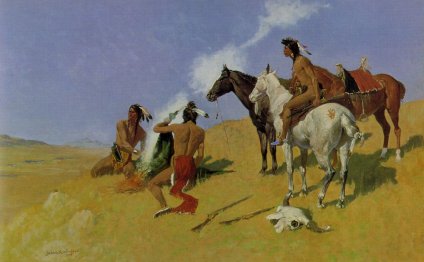
Smoke Signals History
To have established a "set" series of signals equating to consistent meaning would have allowed enemies to " read" the communication as well.
" Fire bowls" have been located and studied on distinct hill tops and are saucer shaped depressions, round or square, five to eight feet across and lined with field stones.
The size, shape and depth of the " fire bowl" was in direct relation to the amount and type of " fuel" to burn to produce the needed smoke.
The stone lining aided in controlling the fire from escape and also provided " props" or "braces" which poles could be laid across with either skins or blankets attached, allowing for control and manipulation of the smoke to produce "puffs" of visible shape and size.
Some of these " fire bowls" or pits have been mapped and studied as they lay in close proximity to the " Warrior Path" that ran between encampments of Shawnee near the Scioto River and Ohio River near Richmondale. This ridge and " path" of location ranges from elevations of six hundred and nine hundred feet.
In general Smoke Signals could signal danger, warning, call the people to a common meeting area, and transmitting news. Smoke could be made to curl in spirals, ascend in puffs or circles, even parallel lines. Some signals resembled the letter V or Y and some were zigzag. There were a few overall accepted meanings . as three puffs in rapid succession usually indicated danger.
Amongst the Apache, the sighting of one puff quickly losing its geometric shape indicated that a strange party had been spotted approaching. If those " puffs" were frequent and rapidly repeated, it transmitted the message that " the stranger approaching" was in fact many in number and armed.
The burning of wood has always been symbolic of transformation. Changing one tangible form into another or others. In this case usually wood being transformed to new elements, ash, lye, smoke, heat and water vapor. Isn't it somewhat amazing that indigenous peoples utilized one aspect of this transformation of the smoke to communicate amongst the people even over long distance?
When the sender " released" the message the receiver would then often times, become the new sender to another receiver, often many times over.
Therefore, in this fashion the information could be transmitted over vast geographic areas with accuracy.
Smoke Signals became Indian telegraphy.
Gram Selma
Resource: Diary of A Visit of Inspection of the Texas Missions made by : Fray Gaspar Jose de Solis, year 1767-1768 translated by Margaret K. Kress with introduction by Mattie A. Hatcher, Southwestern Historical Quarterly. Vol.35.no.1., July 1931
VIDEO REVIEWS



Share this Post
Related posts
History of Smoke Signals
It s a very human characteristic to communicate through the use of gestures and signs. The plains tribes, including the Arapaho…
Read MoreTobacco history facts
Nicotine was isolated from tobacco leaves ( Nicotiana tabacum ) in 1828, but the powerful effects of nicotine were already…
Read More










